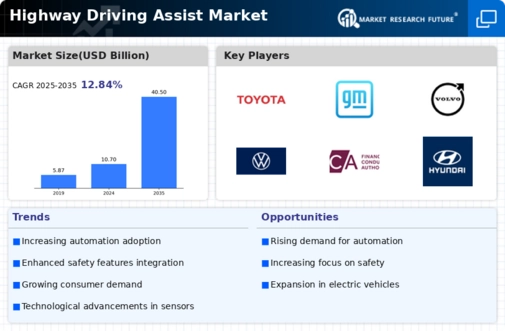Government Regulations and Incentives
Government regulations and incentives play a crucial role in shaping the Highway Driving Assist Market. Many countries are implementing stringent safety standards that require the inclusion of advanced driver-assistance systems in new vehicles. For instance, regulations mandating the installation of automatic emergency braking systems are becoming commonplace. Additionally, governments are offering incentives for consumers who purchase vehicles equipped with these technologies, further stimulating market growth. As of 2025, it is estimated that regulatory frameworks will continue to evolve, pushing manufacturers to innovate and comply with new safety standards. This regulatory environment not only enhances consumer confidence but also drives competition among manufacturers in the Highway Driving Assist Market, as they strive to meet and exceed these requirements.
Rising Consumer Demand for Safety Features
Consumer demand for enhanced safety features is a pivotal driver in the Highway Driving Assist Market. As awareness of road safety increases, consumers are actively seeking vehicles equipped with advanced driving assistance technologies. Surveys indicate that over 70% of potential car buyers prioritize safety features when making purchasing decisions. This trend is further supported by the growing number of road accidents, which has prompted manufacturers to innovate and incorporate safety technologies into their vehicles. The Highway Driving Assist Market is thus witnessing a shift towards vehicles that not only provide comfort but also prioritize the safety of drivers and passengers. This consumer-driven demand is likely to propel market growth, as manufacturers respond to these preferences by integrating more sophisticated safety features into their offerings.
Increased Investment in Autonomous Vehicle Development
The Highway Driving Assist Market is significantly influenced by increased investment in autonomous vehicle development. Major automotive manufacturers and technology companies are allocating substantial resources to research and development aimed at creating fully autonomous driving systems. This investment is expected to yield advancements in highway driving assist technologies, as companies seek to enhance the capabilities of their vehicles. As of 2025, the market for autonomous vehicles is projected to reach several billion dollars, indicating a robust interest in this sector. The push towards autonomy is likely to drive innovation in the Highway Driving Assist Market, as manufacturers integrate more sophisticated features that pave the way for fully autonomous driving experiences.
Technological Advancements in AI and Sensor Technologies
The Highway Driving Assist Market is experiencing a surge in technological advancements, particularly in artificial intelligence and sensor technologies. These innovations enhance vehicle capabilities, allowing for improved lane-keeping, adaptive cruise control, and obstacle detection. As of 2025, the market is projected to grow at a compound annual growth rate of approximately 15%, driven by the integration of advanced driver-assistance systems (ADAS). The proliferation of high-resolution cameras, radar, and LiDAR systems is enabling vehicles to interpret their surroundings more accurately. This technological evolution not only enhances safety but also contributes to a more seamless driving experience. Consequently, manufacturers are increasingly investing in research and development to stay competitive in the Highway Driving Assist Market.
Growing Environmental Concerns and Sustainability Initiatives
Growing environmental concerns and sustainability initiatives are emerging as significant drivers in the Highway Driving Assist Market. As consumers become more environmentally conscious, there is an increasing demand for vehicles that not only offer advanced driving assistance but also promote fuel efficiency and reduced emissions. Manufacturers are responding to this trend by developing hybrid and electric vehicles equipped with highway driving assist technologies. This shift is expected to contribute to a more sustainable transportation ecosystem. By 2025, it is anticipated that the market for electric vehicles will expand, further influencing the Highway Driving Assist Market. The integration of eco-friendly technologies alongside driving assistance features is likely to appeal to a broader consumer base, thereby driving market growth.


















Leave a Comment